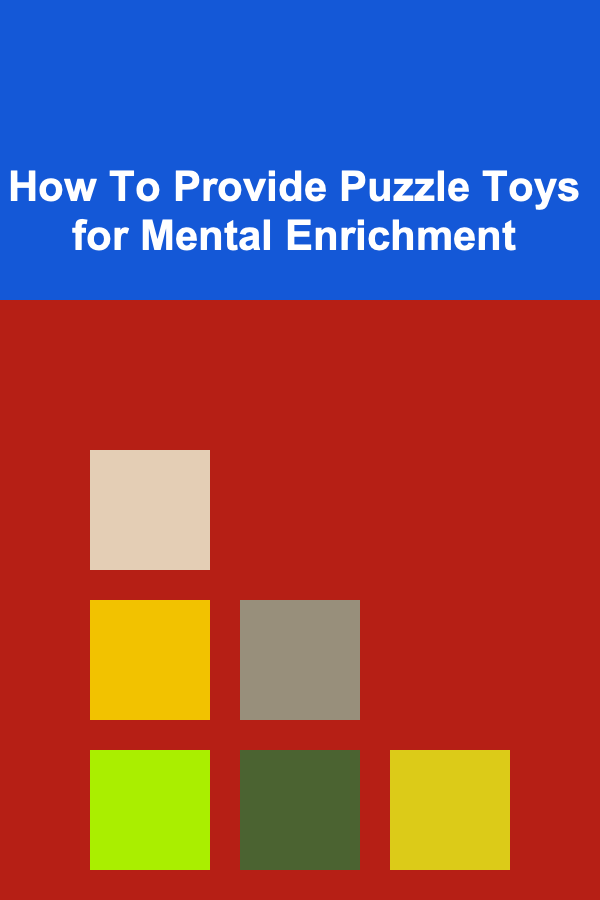
How To Provide Puzzle Toys for Mental Enrichment
ebook include PDF & Audio bundle (Micro Guide)
$12.99$11.99
Limited Time Offer! Order within the next:

In the vibrant tapestry of a pet's life, physical exercise often takes center stage, celebrated for its visible impact on health and vitality. However, a crucial, often underestimated, dimension of well-being is mental enrichment. Just like humans, animals thrive on cognitive stimulation, problem-solving, and the satisfaction of a challenge overcome. This is where puzzle toys emerge as indispensable tools, transforming meal times and idle moments into enriching mental workouts. Providing puzzle toys is not merely about distraction; it's about fostering cognitive health, preventing behavioral issues, and deepening the bond between pet and owner through shared engagement and understanding.
The Indispensable Value of Mental Enrichment
Mental enrichment provides a plethora of benefits that extend far beyond simply keeping an animal busy. It taps into their innate instincts and drives, channeling energy constructively.
- Cognitive Health and Longevity: Engaging the brain helps maintain neural pathways, improving memory, problem-solving skills, and adaptability. For older animals, it can help slow cognitive decline.
- Behavioral Harmony: Boredom and excess energy are root causes of many undesirable behaviors such as destructive chewing, excessive barking, digging, or anxiety. Puzzle toys provide an appropriate outlet, redirecting these tendencies into productive mental work.
- Stress and Anxiety Reduction: The focused activity required to solve a puzzle can be incredibly calming for anxious or stressed animals. It provides a positive coping mechanism, shifting their attention away from stressors.
- Slower Eating and Digestion: For pets who gobble their food, puzzle feeders force them to slow down, aiding digestion, reducing bloat risk, and promoting a feeling of fullness.
- Confidence Building: Successfully conquering a puzzle, even a simple one, can boost an animal's confidence and self-efficacy, encouraging them to tackle new challenges.
- Fulfilling Instincts: Many puzzle toys mimic natural foraging, hunting, or problem-solving behaviors, allowing pets to express innate drives in a safe and rewarding environment.
Types of Puzzle Toys: A Diverse Array of Challenges
The market for puzzle toys is vast and varied, catering to different species, difficulty levels, and engagement styles. Understanding the main categories can help in making informed choices.
1. Food-Dispensing Puzzles (Foraging Toys)
These are perhaps the most popular category, turning mealtime into a scavenger hunt. They range from simple to complex.
- Slow Feeder Bowls/Mats: Not strictly "puzzles," but they introduce obstacles (ridges, mazes) that prevent rapid eating, often a first step towards mental engagement.
- Stuffable Toys (e.g., Kongs): Hollow rubber toys that can be filled with kibble, wet food, peanut butter, or frozen treats. The challenge lies in licking or dislodging the contents. Freezing them increases the difficulty and duration.
- Rolling/Wobbling Dispensers: Toys like treat balls or wobblers that release kibble as the pet nudges, bats, or rolls them around. They encourage physical interaction to get the reward.
- Snuffle Mats: Fabric mats with numerous folds and pockets where kibble or treats can be hidden. Pets use their noses to "snuffle" and find the food, simulating natural foraging.
2. Interactive Manipulation Puzzles
These toys require specific actions, such as sliding, lifting, or pressing, to uncover hidden treats. They often have multiple steps or compartments.
- Sliding Puzzles: Features movable panels or discs that pets must slide to reveal hidden compartments.
- Flip/Lift Puzzles: Require pets to lift lids or flaps, often with their nose or paw, to access treats.
- Lever/Button Puzzles: More complex designs where a specific action, like pressing a button or pulling a lever, releases a treat.
3. Chew-Based Puzzles
While many toys are chewable, some are designed specifically to be chewed on for extended periods to access a treat, combining dental benefits with mental stimulation.
4. DIY and Household Puzzles
Simple household items can be repurposed into effective, cost-efficient puzzle toys. Examples include hiding treats in empty paper towel rolls, within a crumpled paper ball, or under overturned cups.
Choosing the Right Puzzle Toy: A Tailored Approach
The effectiveness of a puzzle toy hinges on selecting one that is appropriate for your individual animal. Consider these factors:
1. Animal Species and Breed Specifics
- Dogs: Consider their size, chewing power, and breed tendencies (e.g., scent hounds excel at snuffle mats, herding breeds might enjoy more structured logic puzzles).
- Cats: Often prefer toys that mimic hunting, like treat balls that can be batted, or hiding food in various locations for a "hunt." Vertical puzzles can also be engaging.
- Birds: Foraging toys that require shredding, dismantling, or manipulating small parts are ideal. Think about toys that can be hung from the cage.
- Small Mammals (Rabbits, Guinea Pigs, Hamsters): Enjoy simple foraging toys, hay balls, or cardboard tubes stuffed with treats. Safety of materials is paramount due to their chewing habits.
2. Difficulty Level
- Start Easy: Introduce puzzles that are simple to solve initially. The goal is success and positive association, not frustration. Leave the toy partially solved or use high-value, easy-to-access treats.
- Gradual Progression: Once your pet masters a level, gradually increase the difficulty. This keeps them engaged and prevents boredom.
- Variety is Key: Don't stick to just one type of puzzle. Rotating toys and introducing new challenges prevents habituation and keeps the mental workout fresh.
3. Temperament and Prior Experience
- Chewers vs. Gentle Explorers: Choose durable materials for power chewers. Delicate puzzles are better suited for pets who are less destructive.
- Novices vs. Experts: An animal new to puzzles will need more guidance and simpler challenges. Experienced puzzle solvers will quickly bore of easy tasks.
- Frustration Threshold: Some animals give up easily when frustrated, while others become more determined. Observe your pet's reaction and adjust accordingly.
4. Size and Durability
Ensure the toy is appropriately sized to prevent choking hazards or ingestion. Materials should be non-toxic and durable enough to withstand your pet's interaction without breaking into small, dangerous pieces.
5. Ease of Cleaning
Especially for food-dispensing toys, ease of cleaning is important for hygiene and preventing bacterial growth.
How to Introduce and Maximize Puzzle Toy Effectiveness
Providing a puzzle toy isn't just about handing it over; it's about a strategic introduction and ongoing management to ensure maximum benefit.
- Preparation is Crucial:
- Choose High-Value Treats: Especially for initial introductions, use treats your pet absolutely loves.
- Clean the Toy: Always ensure the toy is clean before filling.
- Start Simple: Make the first few interactions incredibly easy. For a treat ball, leave some treats visibly sticking out. For a slide puzzle, leave some panels slightly ajar.
- Supervised Introduction:
- Always supervise your pet during their first few encounters with a new puzzle toy. This allows you to guide them, prevent frustration, and ensure safety.
- Offer gentle encouragement. Point to the toy, tap it, or demonstrate (if appropriate for the toy and your pet's understanding).
- Praise and reward them immediately when they make progress or solve a step.
- Progression, Not Perfection:
- Once your pet consistently solves a puzzle, gradually increase the difficulty. This might mean using stickier treats in a Kong, closing all compartments in a slide puzzle, or introducing a new, slightly more complex toy.
- The goal is consistent engagement, not immediate mastery.
- Integrate into Routine:
- Don't just offer puzzle toys when you need to keep your pet busy. Integrate them into daily routines, such as using a puzzle feeder for regular meals, or offering a puzzle toy before you leave the house to create a positive association with your departure.
- Consider using puzzle toys as a replacement for a portion of their meal, rather than just extra treats.
- Rotation and Novelty:
- Rotate through a selection of 3-5 different puzzle toys to keep things fresh. Animals, like humans, can get bored of the same challenge.
- Introduce a new puzzle toy periodically to provide a novel experience.
- Observe and Adapt:
- Pay close attention to your pet's body language. Signs of frustration (giving up, chewing the toy instead of solving it, excessive whining) mean the puzzle might be too difficult.
- Signs of boredom (ignoring the toy, quickly solving it and walking away) mean it might be too easy.
- Adjust the difficulty or rotate the toy as needed.
Beyond Dogs: Puzzle Toys for All Companions
While often associated with dogs, the concept of mental enrichment through puzzle toys is universally beneficial across species.
- For Cats: Cats are natural hunters and foragers. Puzzle toys can mimic this by requiring them to bat, pounce, or extract food. Treat balls, puzzle feeders that hide kibble in various compartments, or even scattering their kibble around the room can satisfy their hunting instinct.
- For Birds: Birds are highly intelligent and curious. Foraging toys that require them to shred paper, untie knots, or manipulate objects to get a treat are excellent. Vary textures, colors, and materials to keep them engaged.
- For Rabbits and Guinea Pigs: These small herbivores thrive on foraging. Hay balls, cardboard tubes stuffed with hay and a few greens, or small treat-dispensing balls are ideal. Ensure all materials are safe for consumption.
- For Ferrets: Known for their curiosity and ability to get into small spaces, ferrets enjoy rolling treat balls or toys that require them to root out hidden rewards.
Safety First: Important Considerations
While enriching, puzzle toys must be used safely to prevent harm.
- Supervision: Always supervise your pet, especially when introducing a new toy, to ensure they interact with it safely and don't ingest non-food parts.
- Appropriate Size: Ensure the toy is too large to be swallowed whole and that any small parts cannot be easily chewed off and ingested.
- Durability and Condition: Regularly inspect toys for wear and tear. Discard any damaged toys that could pose a choking hazard or have sharp edges.
- Non-Toxic Materials: Always choose toys made from non-toxic, pet-safe materials.
- Treat Choices: Use healthy, appropriately sized treats or kibble. Avoid excessive high-calorie treats.
- Cleanliness: Food-dispensing toys can harbor bacteria if not cleaned regularly. Follow manufacturer's cleaning instructions.
Conclusion
Providing puzzle toys for mental enrichment is a profound act of care that extends beyond mere physical needs. It acknowledges the complexity of our pets' minds, recognizing their innate desire to learn, explore, and solve. By thoughtfully selecting, introducing, and rotating these engaging tools, we empower our companions to lead fuller, more stimulated lives. This not only prevents boredom and mitigates behavioral challenges but also strengthens the unique bond we share, as we witness the satisfaction and joy they derive from a challenge overcome. Invest in their minds, and you invest in a happier, healthier, and more harmonious life together.

How to Design a Space-Saving Nursery for Your Baby's Room
Read More
How to Organize Your Kitchen with Creative Storage Ideas
Read More
How to Start a Business Selling Homemade Watercolors: A Beginner's Guide
Read More
How to Store Seasonal Decorations Outdoors
Read More
How To Paint Landscapes in Plein Air
Read More
How to Develop a Yoga Sequence for Relaxation
Read MoreOther Products

How to Design a Space-Saving Nursery for Your Baby's Room
Read More
How to Organize Your Kitchen with Creative Storage Ideas
Read More
How to Start a Business Selling Homemade Watercolors: A Beginner's Guide
Read More
How to Store Seasonal Decorations Outdoors
Read More
How To Paint Landscapes in Plein Air
Read More